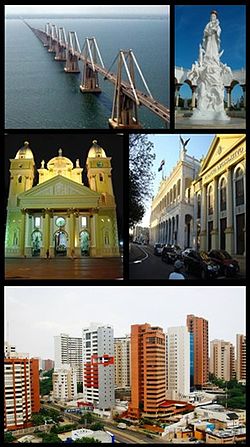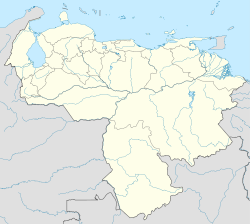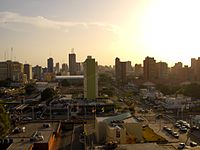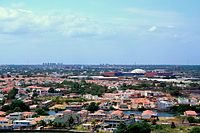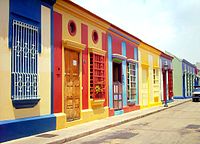- Maracaibo
-
For the lake by the same name, see Lake Maracaibo.
Maracaibo — Municipality — Ciudad Autónoma de Maracaibo Top Left: General Rafael Urdaneta Bridge, Top Right: Monument to Our Lady of Chiquinquirá, middle lef; Maracaibo Basilica, middle right; Governmental palace. Bottom: Buildings 5 de Julio Avenue 
Flag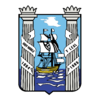
SealNickname(s): "La Tierra del Sol Amada"
(English: "The Beloved Land of the Sun")Motto: "Muy noble y leal"
(English: "Very noble and loyal")Coordinates: 10°39′N 71°38′W / 10.65°N 71.633°WCoordinates: 10°39′N 71°38′W / 10.65°N 71.633°W Country  Venezuela
VenezuelaState Zulia Municipality Maracaibo Founded 8 September 1529 Founder Ambrosio Alfinger Government – Type Mayor-council – Body Alcaldía de Maracaibo – Mayor Eveling Trejo de Rosales (UNT) Area – Metro 1,393 km2 (537.8 sq mi) Elevation 6 m (20 ft) Population (2010) – Rank 2nd – Urban[1] 1,495,199 – Metro[2] 2,108,404 Demonym Marabino(a), Maracaibero(a), Maracucho(a) Time zone VST (UTC-04:30) – Summer (DST) not observed (UTC-04:30) Postal coded 4001, 4002, 4003, 4004, 4005 Area code 261 ISO 3166 code VE-A Website Alcaldía de Maracaibo (Spanish) The area and population figures are for the municipality. Maracaibo (Spanish pronunciation: [maɾaˈkaiβo]) is a city and municipality located in northwestern Venezuela off the western coast of the Lake Maracaibo. It is the second-largest city in the country after the national capital Caracas and the capital of Zulia state. The population of the city is approximately 1,495,200 [1] with the metropolitan area estimated at 2,108,404 as of 2010.[2]
Maracaibo is nicknamed La Tierra del Sol Amada ("The Beloved Land of the Sun").
Contents
Etymology
The name Maracaibo comes from the brave Cacique (Indian Chief) Mara, a young native who valiantly resisted the Germans and died fighting them. It is said that when Mara fell, the Indians shouted "Mara cayo!" (Mara fell!), thus originating the city name. Other historians say that the first name of this land in Indian language was "Maara-iwo" meaning "Place where serpents abound".
History
Foundation
The first indigenous settlements were of Arawak and Carib origin. Around the main group were the Añu tribe who built rows of stilt houses all over the northern riviera of the Lake Maracaibo.[3] The first Europeans arrived in 1499.
The city was founded three times: First in 1529 by the German Ambrosio Alfinger, who named it Villa de Maracaibo. The lack of activity in the zone made Nicolas de Federman evacuate the village in 1535 and move its population to Cabo de la Vela nearby Coro. A second attempt by Captain Alonso Pacheco turned into failure. The third foundation of the city occurs in 1574 when Captain Pedro Maldonado, under Governor Diego de Mazariego's command, establishes the village with the name of Nueva Zamora de Maracaibo. "Nueva Zamora" comes from Mazariego's place of birth, Zamora, in Spain. Since its definite foundation, the town began to develop as a whole. It is based on the western side of Lake Maracaibo, the dominant feature of the oil-rich Maracaibo Basin. Favoured by prevailing winds and a protected harbour, the city is located on the shores of the lake where the narrows, which eventually lead to the Gulf of Venezuela, first become pronounced.
Pirates' Attacks
In March of 1669, Henry Morgan sacked Maracaibo, which emptied when his fleet was first spied, and moved on to the Spanish settlement of Gibraltar on the inside of Lake Maracaibo in search of more treasure. A few weeks later, when he attempted to sail out of the lake, Morgan found an occupied fort blocking the inlet to the Caribbean, along with three Spanish ships. These were the Magdalena, the San Luis, and the Soledad. He destroyed the Magdalena and burned the San Luis by sending a dummy ship full of gunpowder to explode near them, after which the crew of the Soledad surrendered. By faking a landward attack on the fort, thereby convincing the Spanish governor to shift his cannon, he eluded their guns and escaped.[4]
Independence era
In 1810 the province of Maracaibo did not join the first republic of Venezuela and remained loyal to the Spanish crown. Maracaibo then held the seat of the Captaincy General of Venezuela. In 1821 uprisings in favour of independence began conducting to warfare and hostility. The royalists, led by Francisco Tomás Morales, fought with the patriots, led by Rafael Urdaneta, to take back control over the province in the Juana de Ávila Battle and Morales brought back Spanish rule in 1822 until he was defeated at the Battle of Lake Maracaibo on 24 July 1823 culminating Venezuela's struggle for independence.
Isolation period
For about 390 years, Maracaibo remained isolated and separated from the rest of the country. Transportation was only possible across the lake by ferry or other marine transport.
Cars, buses, and lorries, with their constant flow of manufactured goods and agricultural product, depended on the ferry system between the city and the eastern shore with their roads to connect to the country's motorway system. Maracaibo and the Lake Maracaibo region's economy was more linked to Colombia than to eastern Venezuela due to the natural route available through Lake Maracaibo then leading to the sea.
This isolation was both a challenge and an advantage. The very nature of the city's location made for a population known for their independent thought and character. The history of this region is rife with stories about the creation of an independent and sovereign nation apart from Venezuela, a nation called La República Independiente del Zulia, which means The Independent Republic of Zulia, but this has never come to be.
Building of the bridge
The dictatorial regime of General Marcos Pérez Jiménez in the 1950s set as a goal the construction of a bridge connecting the two lake shores. Various bridge projects for the spanning of the Lake Maracaibo narrows near the city were in the works. The general's government had decided that this "city of independent thought" should be more "connected" to the rest of the country.
Proposals for a bridge design that included rail transport and tourist facilities were seriously considered. The fall of the Pérez Jiménez government on January 23, 1958, quickly led to a less elaborate design project that was approved and funded by a democratic and more conservative government.
The building of "El Puente Sobre El Lago de Maracaibo "General Rafael Urdaneta"—(General Rafael Urdaneta Bridge over Lake Maracaibo) named after the distinguished General hero of the War of Independence was opened to public traffic in 1962. The project was completed on schedule in 40 months.
This bridge construction project was a remarkable feat. Built under very difficult conditions, when completed, it became the longest prestressed concrete bridge in the world. The structure is in constant use and remains today as the most important link between Maracaibo, along with much of the state of Zulia, and the rest of Venezuela.
Modern times
Maracaibo has become a large metropolitan city, comprising two municipalities: to the north the municipality of Maracaibo and to the south the San Francisco municipality (established in 1995). In recent years, due to political/economic and cultural reasons, many have moved to Maracaibo from rural areas and other cities (including Caracas).
In the political arena, the citizens of Maracaibo (and most other cities and municipalities in Zulia state) have in recent years voted for a competitive political system in where the governor is from a certain political party and the mayor or mayors are from the opposite political party. This system has brought many good things to the city and the state; for example, if the governor builds a bridge, one of the mayors will build two, if a mayor cleans a public park, the governor retaliates by cleaning and remodelling another one.
Maracaibo also boasts one of the best universities in the country, the state university. La Universidad del Zulia (LUZ) is well renowned for its excellent law, medical and engineering schools as many other disciplines. Other universities and schools include Universidad Dr. Rafael Belloso Chacín (URBE) and Universidad Rafael Urdaneta, with one of the country's leading psychology schools.
Maracaibo was elevated to the status of Roman Catholic Archdiocese on 30 April 1966 with the creation of the Archdiocese of Maracaibo.[5] Since November 2000, its Archbishop has been Ubaldo Ramón Santana Sequera.
Perspective
François de Pons, an agent to the French government in Caracas, provides some historical insight into the people of Maracaibo in his travel journal (de Pons 1806). The following excerpts describe the local population of Maracaibo:
- They perform coasting, or long voyages, with equal facility; and when all trade is suspended by the operations of war, they enter privateers. Bred up in the neighbourhood of the lake, they are mostly all expert swimmers and excellent divers. Their reputation stands equally high as soldiers. Those who do not enter into the sea service, form plantations, or assist in cultivating those that belong to their fathers. Nothing proves better their aptitude for this kind of occupation, than the immense flocks of cattle with which the savannas of Maracaybo [sic] are covered.
He also notes the appreciation of literature, the arts, education, and culture among the people of Maracaibo:
- But what confers the greatest honour on the inhabitants of Maracaibo, is their application to literature; in which, notwithstanding the wretched state of public education, they make considerable progress....They likewise acquired the art of elocution, and of writing their mother tongue with the greatest purity; in a word, they possessed all the qualities that characterise men of letters.
During the period of de Pons' visit, however, he believed the men of Maracaibo to lack integrity with regard to honouring their commitments:
- After allowing that the inhabitants of this city possess activity, genius, and courage, we have nothing further to say in their praise. They are accused of violating their promises, and even of attempting to break through written engagements. Their character, in this respect, is so notorious, that every stranger whom business induces to visit Maracaybo, affirms, that it would be much better to enter into commercial speculations with the women, because they appear themselves to possess that sincerity and good sense that are every where else considered as belonging particularly to men.
Local government
Maracaibo has one municipality: Maracaibo Municipality, Venezuelan law specifies that municipal governments have four main functions: executive, legislative, comptroller, and planning. The executive function is managed by the mayor, who is in charge of representing the municipality's administration. The legislative branch is represented by the Municipal Council, composed of seven councillors, charged with the deliberation of new decrees and local laws. The comptroller tasks are managed by the municipal comptroller's office, which oversees accountancy. Finally, planning is represented by the Local Public Planning Council, which manages development projects for the municipality. According to United Nations reports, Maracaibo like Caracas has significant infrastructure deficiencies under current government, including shortfalls in clean drinking water.[6]
Economy
Chemical production
Geography
Location
The city of Maracaibo is located at the denominated Maracaibo plain. It has low fertility, typical of a dry-tropical forest. It presents a great number of rivers, sewers and gorges. The city dominates the entrance to Lake Maracaibo.
Climate
Maracaibo is one of the hottest cities of Venezuela. The rain shadow of the Sierra Nevada de Santa Marta gives the city a semiarid climate, only attenuated by the moderating influence of the lake; its average historical temperature is 29 °C (84 °F). In the past the climate of the city, as well in all the coast of the Lake Maracaibo, was unhealthy, due to the combination of high temperatures with high humidity. At the present time, the effects of urban development, and control of plagues, has almost eradicated that. The registered high temperature of the city is 41 °C (106 °F), and the lowest is 18 °C (64 °F).
Climate data for Maracaibo (1961-1990) Month Jan Feb Mar Apr May Jun Jul Aug Sep Oct Nov Dec Year Average high °C (°F) 32.5
(90.5)32.8
(91.0)33.1
(91.6)33.1
(91.6)33.1
(91.6)33.6
(92.5)34.1
(93.4)34.2
(93.6)33.6
(92.5)32.5
(90.5)32.4
(90.3)32.5
(90.5)33.13
(91.63)Average low °C (°F) 22.8
(73.0)23.2
(73.8)24.1
(75.4)24.8
(76.6)25.0
(77.0)24.9
(76.8)24.9
(76.8)24.9
(76.8)24.6
(76.3)24.1
(75.4)24.1
(75.4)23.3
(73.9)24.23
(75.61)Rainfall mm (inches) 5
(0.2)3
(0.12)6
(0.24)52
(2.05)67
(2.64)55
(2.17)26
(1.02)60
(2.36)104
(4.09)114
(4.49)71
(2.8)17
(0.67)580
(22.83)Avg. rainy days (≥ 1.0 mm) 0.6 0.3 0.6 3.6 6.1 6.7 3.6 5.8 8.1 9.2 5.3 1.7 51.6 Sunshine hours 266.6 242.9 244.9 183.0 179.8 201.0 244.9 232.5 192.0 182.9 204.0 238.7 2,613.2 Source: Hong Kong Observatory[7] Colleges and universities
Several universities are based in the city:
- Universidad del Zulia - (LUZ)
- Universidad Nacional Experimental de la Fuerza Armada UNEFA
- Universidad Rafael Belloso Chacín - (URBE)
- Universidad Rafael Urdaneta
- Universidad Católica Cecilio Acosta
- Universidad Dr. José Gregorio Hernández
- Universidad Bolivariano de Venezuela sede Zulia
Transportation
- The Maracaibo Metro, also known as Metro del Sol Amado (due to the city nickname), is a subway system currently under construction, it encompasses the suburbs of Maracaibo with the city's downtown. Currently, six metro stations are open and running.
- Buses are the main means of mass transportation, this system runs a variety of bus types, operated by several companies on normal streets and avenues:
- bus; large buses.
- buseta; medium size buses.
- microbus or colectivo; vans or minivans.
- por puesto; cars.
- La Chinita International Airport, was opened on November 16, 1969, during the government of president Rafael Caldera to open a gate to the western part of the country and alleviate congestion from the Simon Bolivar Airport near Caracas, which manages about 90% of the international flights in Venezuela. In fact, the only international destinations from Maracaibo are Aruba, Bogotá, Barranquilla, Cartagena, Curaçao, Miami and Panama City.
- General Rafael Urdaneta Bridge, inaugurated in 1962, is located at the outlet Lake Maracaibo, in western Venezuela. The bridge connects Maracaibo with much of the rest of the country. It is named after General Rafael Urdaneta, a Venezuelan hero in the War of Independence.
Made of concrete, it spans 8.7 kilometres (5.4 mi). The bridge is a cable-stayed bridge that carries only vehicles. The competition to design the bridge started in 1957 and was won by Riccardo Morandi, an Italian. Construction was done by several companies. They included: Grün & Bilfinger, Julius Berger, Bauboag AG, Philipp Holzmann AG, Precomprimido C.A., Wayss & Freytag and K Ingeniería.
Sports
Due to the regionalistic nature of Marabinos, they strongly support their native teams. Maracaibo, and the rest of Zulia, are represented in baseball by the Águilas del Zulia, a Venezuelan winter league team that plays in the Liga Venezolana de Béisbol Profesional,and is based in the Estadio Luis Aparicio El Grande. Regional teams include the Unión Atlético Maracaibo and the Zulia FC in football, and the Gaiteros del Zulia in basketball, a team that participates in the Liga Profesional de Baloncesto de Venezuela, whose home is the 5.000-people Pedro Elías Belisario Aponte stadium.
Their city has one football stadium:
- Estadio José Pachencho Romero, constructed in 1971 for the Juegos Deportivos Bolivarianos, and redesigned in 1998, for the Juegos Deportivos Centroamericanos y del Caribe. It is named after an athlete from Zulia. With a capacity of 26 000 spectators is being extended to 35 000 for the Copa América 2007.
In the 2000 Little League World Series, the Sierrra Maestra Little League of Maracaibo, Venezuela defeated Bellaire Little League of Bellaire, Texas in the championship game of the 54th Little League World Series. The Coquivoca Little League team from Maracaibo placed third in the 1974 Little League World Series.
Teams
- Baseball: Águilas del Zulia BBC.
- Soccer: Unión Atlético Maracaibo, Zulia FC
- Basket: Gaiteros del Zulia
- Rugby: [Maracaibo Rugby Football Club "Oil Blacks"]
Culture
Culture in Maracaibo is very indigenous and unique, is recognized in every state and city in Venezuela, and is very influential with its gaitas, desserts, style, living, and customs. Most major houses of advertising in Venezuela acknowledge how opposite the culture of Maracaibo is from that of Caracas. Studies of both prove, for example, that Caracas' leading soft drink brand is Coke, while in Maracaibo it is Pepsi. This has made many brands create special localised advertising of their products (including several Pepsi commercials spoken by local celebrities).
Maracuchos are extremely proud of their city, their culture, and all of Zulia. They usually claim that Venezuela wouldn't be the country it actually is without Zulia. Rivalry with inhabitants of other regions is common, specially with Gochos (people of the Mérida and Táchira state) and Caraqueños (people of the city of Caracas).
An interesting aspect of the city, is the humor and the musical culture of its people, the Gaita Zuliana, is a traditional christmas music from the region. It is known that Maracaibo was culturally separated from the rest of Venezuela, for geographical and historical reasons. The Lake Maracaibo maintained separated the city, with its neighboring states and Caracas, capital of Venezuela. The people from Maracaibo, having been influenced by Andalusian colonists, apply the term "vos" instead of tú (English: "you"). The "vos" term, the fast speaking and the strong tone of the voice, produced a particular style, that nowadays is a “mark of origin” of the people from Maracaibo.
The city is also home to an array of immigrants from but not limited to: Spain, Italy, Germany, and Latin American countries.
The General Rafael Urdaneta Bridge, the freeway Machiques — Colón, and the ship transportation, unites the communications of the city, with the rest of Venezuela, this united with the oil boom, cultivated since 1914, is going to conform a new Maracaibo.
Our Lady of Rosario of Chiquinquirá
Main article: Our Lady of the Rosary of ChiquinquiráIs one of the many popular representations of the Virgin Mary in Venezuela. The image is most venerated in Maracaibo. The story of discovery of the virgin dates from the 18th century. An old lady would make a living by washing other people's clothes, a job she did every morning at the shores of the lake. On 18 November 1709, she had taken a bulk of clothes, and as usual, headed to the lake to start washing them. This old lady was at her chores when she saw a wooden board floating towards her. She picked it up thinking that it might be of some use. When she finished her work, she went home carrying the clothes, the board and a small vase with fresh water. She then placed the board on top of the vase. Then, she noticed a small figure in the board but could not tell what it was like.
She fell asleep, and when she awoke up it was already late and dark. She decided to go to a local grocery store to buy some candles. On her way back a small gathering of people had formed outside her house, and after coming closer she noted that her home was filled with light. After entering she and some of the neighbours witnessed the small wooden board floating in the air surrounded by light with a bright crisp image of the Virgin Mary. At this, everyone was amazed and called the event a miracle.
Since that day the street where she lived was renamed "El Milagro," which means ¨Miracle¨ in Spanish, and to this day it is one of the most important streets in the neighbourhood of "El Saladillo" in the city of Maracaibo. There is a church in Maracaibo honoring her, La Chiquinquirá Church.
Gaita Zuliana
Main article: Gaita ZulianaThe Gaita is the name of an Afro Venezuelan folk music from Maracaibo, it is normally considered a christmas-time music. According to Joan Corominas, it popularised in the middle 1960s in all the country, and it fused with other types of music like salsa and merengue in the 1970s. There are many famous Gaita groups like: Maracaibo 15, Gran Coquivacoa, Barrio Obrero,Alitasia, Cardenales del Éxito, Guaco (when Guaco started was a gaita group, now is a Tropical music band), Koquimba, Melody Gaita, Estrellas del Zulia, Saladillo, and many others.
Museums, Cultural Centers and Theaters
- Museo de Arte Contemporáneo del estado Zulia (MACZUL).
- Museo General Rafael Urdaneta.
- Museo Municipal de Artes Gráficas "Balmiro León".
- Centro de Bellas Artes de Maracaibo.
- Centro de Arte de Maracaibo “Lía Bermúdez”.
- Teatro Baralt.
Libraries
- Biblioteca Publica del Zulia.
- Biblioteca Pública "Arturo Uslar Pietri".
- Biblioteca "Dr. Pedro Alciro Barboza de la Torre".
- Biblioteca Pública "Simón Palmar".
- Biblioteca Pública "Luís Guillermo Pineda Belloso".
- Biblioteca Pública Especializada "Pedagógica".
- Biblioteca Pública Especializada "SEDINI".
Notable natives
- Teo Acosta - Baseball Player
- Ricardo Aguirre - Composer and singer.
- Wilson Alvarez - Former Major League Baseball left-handed pitcher.
- Luis Aparicio - Former shortstop in Major League Baseball and a member of the Baseball Hall of Fame.
- José Domingo de las Nieves Rus y Ortega Azarraulia - Statesman of high caliber who abrogated for the secession of Zulia as a separate and independent state. Born in 1768, he went on to become sole representative (deputy) of his native city, Maracaibo, at the famous Cortes de Cádiz (Law Courts), in Spain, where he labored tenaciously on behalf of the city’s Charter. In the early years of the XIX c., he achieved the highest rank attainable in Spanish-colonial America: that of Juris-Consultant to the Royal Audience of Guadalajara (Mexico) - the highest Court of Appeals in the lands belonging to the Viceroyalty of New Spain (today’s Central America, Mexico, and the southern United States). After the War of Independence, he became Supreme Court Justice of the recently constituted country of Mexico; serving in that capacity until 1830, dying five years later in 1835.
- Rafael Maria Baralt - Illustrious Venezuelan diplomat and one of the country’s most famed writers, philologists, and historians. He was the first Latin American to occupy a chair at the ‘Real Academia Española’. Born on 3 July 1810, he suffered an untimely death due to the stresses and aggravations suffered during services rendered to his beloved country of birth. He died on 4 January 1860, and is buried in the National Pantheon of Venezuela..
- Gustavo Chacín - MLB starting pitcher for the Toronto Blue Jays.
- Gilberto Correa - TV host.
- David Cubillan - Basketball player, Marquette University.
- Chiquinquirá Delgado - actress & TV host.
- Lupita Ferrer - Actress.
- Juan Bautista Fuenmayor - Historian, politician, lawyer, teacher, and founder of the first petroleum syndicates.
- Betulio González - Former boxer.
- Carlos González - MLB outfielder for the Colorado Rockies.
- Geremi González - MLB player for the Chicago Cubs, Tampa Bay Devil Rays, Boston Red Sox, New York Mets, and the Milwaukee Brewers.
- Juan Pablo Guanipa - Political leader.
- Jonathan Herrera - second baseman for the Colorado Rockies.
- Ninibeth Leal - Miss World 1991.
- Jesús Enrique Lossada - Journalist, lawyer, parliamentary, President of the Universidad del Zulia, teacher, writer.
- Carlos Meyer - Fighter pilot. The only Latin American member (though ethnic German) of the Red Baron's flying circus, awarded the Iron Cross during World War I.[8]
- Armando Molero - Songwriter.
- Fernando Antonio Bermudez Arias - Doctor, cardiologist, scientist, writer, teacher, historian, artist and social defender.
- Carlos Caridad-Montero - film producer
- Humberto Fernández Morán - A research scientist. He developed the diamond scalpel and founded "IVIC", the Venezuelan scientific research institute ("Instituto Venezolano de Investigaciones Cientificas")
- Luis Montiel - Wayuu tapistry artist. "...Era conocido nacional e internacionalmente como el artista del tapiz guajiro. A los 74 años y en su lar nativo de Alistasia, murio en pleno corazón del territorio Wayuu"
- Lila Morillo - Actress & singer.
- Francisco Ochoa - First President of the Universidad del Zulia.
- Udon Perez - Author of the Zulia State Anthem.
- Francisco Javier Pirela - Conspirator against the Spanish Crown.
- Venancio Pulgar - Zulian caudillo, partisan for the independence of the region.
- Nick Pocock - Former cricketer, ex-captain of Hampshire.
- Joaquin Primo de Rivera - Governor, shifted industrialization in the state.
- [Oscar Romero] - Famed Tokyo expatriate.
- Daniel Sarcos - TV host.
- Monica Spear - Miss Universe 2005 4th runner up.
- Orlando Urdaneta - Actor.
- Rafael Urdaneta - Hero of the Latin American war for independence.
- Vivian Urdaneta - Miss International 2000.
- Patricia Velásquez - Actress and fashion model.
Districts
Maracaibo Districts Venancio Pulgar • Idelfonso Vázquez • Coquivacoa • Barrio 18 de Octubre • Juana de Ávila • El Naranjal • San Jacinto (La Marina) • Mara Norte • La Trinidad • Las Tarabas • La Estrella • Maracaibo I • Maracaibo II • Lago Mar Beach • Antonio Borjas Romero • San Isidro • Francisco Eugenio Bustamante • San Rafael • Ziruma • San Miguel • Luis Hurtado Higuera • Manuel Dagnino • Cristo de Aranza • Cecilio Acosta • Cacique Mara • El Amparo • Raúl Leoni • Caracciolo Parra Pérez • Los Olivos • Chiquinquirá • Santa Lucía • Santa Rosa • Bolívar • Bella Vista • Historic zone of Maracaibo • El Saladillo • Isla Dorada Sister cities
Maracaibo has six sister cities:[9]
 Bremen, Germany
Bremen, Germany Durban, South Africa
Durban, South Africa Honolulu, Hawaii, United States of America
Honolulu, Hawaii, United States of America New Orleans, United States of America
New Orleans, United States of America Ploieşti, Romania
Ploieşti, Romania San Juan, Puerto Rico
San Juan, Puerto Rico
Skyline
Line note references
- ^ a b http://www.ine.gov.ve/seccion/poblacion/magnitudestructura/Trabajo.asp?CodigoEstado=24&TipoPublicacion=Proyecciones&AreaDePublicacion=poblacion&AnoBaseCenso=2001&CodigoCuadro=Cuadro_06&ControlHref=14&strHref=MunicipioMaracaibo&strMunicipioX=Municipio$Maracaibo
- ^ a b http://www.ine.gov.ve/seccion/poblacion/magnitudestructura/MenuMagnitud.asp?Codigo_Estado=24&Publicacion=Proyecciones&AnoBaseCenso=2001&AreaDepublicacion=poblacion&seccion=2&nedo=24#
- ^ http://www.efemeridesvenezolanas.com/html/maracaibo.htm
- ^ {{<Harry Morgans Way (AlisonPress 1977) author; Dudley Pope>}}<Caribbean;author;James A.Michener, Guild Publishing ,1989>
- ^ Maracaibo (Archdiocese) [Catholic-Hierarchy]
- ^ United Nations Children's Fund (UNICEF). New York, NY. "Safe Drinking Water." Excerpt from "Progress since the World Summit for Children: A Statistical Review." September 2001.
- ^ Climatological Information for Maracaibo, Venezuela
- ^ [1]
- ^ Sister Cities designated by Sister Cities International, Inc. (SCI). Retrieved June 8, 2006.
References
de Pons, François (1806), A Voyage to the Eastern Part of Terra Firma, or the Spanish Main, in South-America, during the years 1801, 1802, 1803, and 1804, New York: I. Riley and Company
External links
- (Spanish) Panorama Digital -Largest Maracaibo based newspaper
- (Spanish) La Verdad - Maracaibo-based newspaper.
 State capitals of VenezuelaCapital, stateBold indicates national capital.Categories:
State capitals of VenezuelaCapital, stateBold indicates national capital.Categories:- Maracaibo
- Populated places in Venezuela
- Lake Maracaibo
- Port cities in the Caribbean
- Port cities in Venezuela
- Populated places established in 1529
- Ports and harbours of Venezuela
Wikimedia Foundation. 2010.

